Qingqing Huang
Seed-Music: A Unified Framework for High Quality and Controlled Music Generation
Sep 13, 2024



Abstract:We introduce Seed-Music, a suite of music generation systems capable of producing high-quality music with fine-grained style control. Our unified framework leverages both auto-regressive language modeling and diffusion approaches to support two key music creation workflows: \textit{controlled music generation} and \textit{post-production editing}. For controlled music generation, our system enables vocal music generation with performance controls from multi-modal inputs, including style descriptions, audio references, musical scores, and voice prompts. For post-production editing, it offers interactive tools for editing lyrics and vocal melodies directly in the generated audio. We encourage readers to listen to demo audio examples at https://team.doubao.com/seed-music .
Seed-TTS: A Family of High-Quality Versatile Speech Generation Models
Jun 04, 2024



Abstract:We introduce Seed-TTS, a family of large-scale autoregressive text-to-speech (TTS) models capable of generating speech that is virtually indistinguishable from human speech. Seed-TTS serves as a foundation model for speech generation and excels in speech in-context learning, achieving performance in speaker similarity and naturalness that matches ground truth human speech in both objective and subjective evaluations. With fine-tuning, we achieve even higher subjective scores across these metrics. Seed-TTS offers superior controllability over various speech attributes such as emotion and is capable of generating highly expressive and diverse speech for speakers in the wild. Furthermore, we propose a self-distillation method for speech factorization, as well as a reinforcement learning approach to enhance model robustness, speaker similarity, and controllability. We additionally present a non-autoregressive (NAR) variant of the Seed-TTS model, named $\text{Seed-TTS}_\text{DiT}$, which utilizes a fully diffusion-based architecture. Unlike previous NAR-based TTS systems, $\text{Seed-TTS}_\text{DiT}$ does not depend on pre-estimated phoneme durations and performs speech generation through end-to-end processing. We demonstrate that this variant achieves comparable performance to the language model-based variant and showcase its effectiveness in speech editing. We encourage readers to listen to demos at \url{https://bytedancespeech.github.io/seedtts_tech_report}.
V2Meow: Meowing to the Visual Beat via Music Generation
May 11, 2023
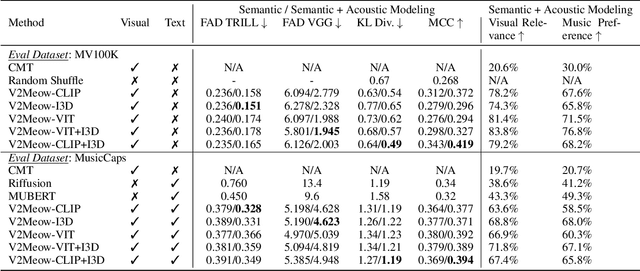

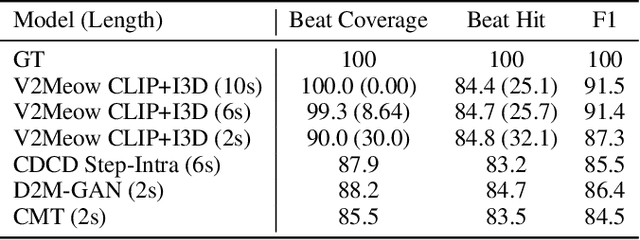
Abstract:Generating high quality music that complements the visual content of a video is a challenging task. Most existing visual conditioned music generation systems generate symbolic music data, such as MIDI files, instead of raw audio waveform. Given the limited availability of symbolic music data, such methods can only generate music for a few instruments or for specific types of visual input. In this paper, we propose a novel approach called V2Meow that can generate high-quality music audio that aligns well with the visual semantics of a diverse range of video input types. Specifically, the proposed music generation system is a multi-stage autoregressive model which is trained with a number of O(100K) music audio clips paired with video frames, which are mined from in-the-wild music videos, and no parallel symbolic music data is involved. V2Meow is able to synthesize high-fidelity music audio waveform solely conditioned on pre-trained visual features extracted from an arbitrary silent video clip, and it also allows high-level control over the music style of generation examples via supporting text prompts in addition to the video frames conditioning. Through both qualitative and quantitative evaluations, we demonstrate that our model outperforms several existing music generation systems in terms of both visual-audio correspondence and audio quality.
Noise2Music: Text-conditioned Music Generation with Diffusion Models
Feb 08, 2023
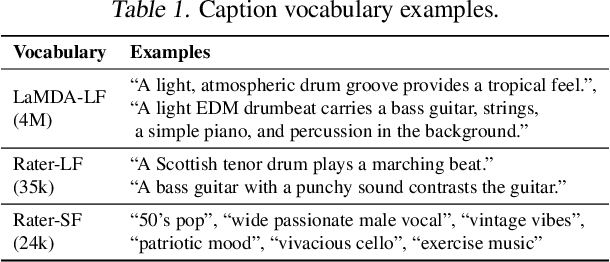

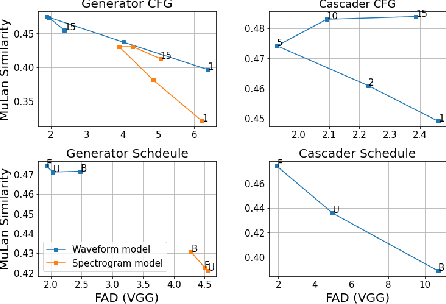
Abstract:We introduce Noise2Music, where a series of diffusion models is trained to generate high-quality 30-second music clips from text prompts. Two types of diffusion models, a generator model, which generates an intermediate representation conditioned on text, and a cascader model, which generates high-fidelity audio conditioned on the intermediate representation and possibly the text, are trained and utilized in succession to generate high-fidelity music. We explore two options for the intermediate representation, one using a spectrogram and the other using audio with lower fidelity. We find that the generated audio is not only able to faithfully reflect key elements of the text prompt such as genre, tempo, instruments, mood, and era, but goes beyond to ground fine-grained semantics of the prompt. Pretrained large language models play a key role in this story -- they are used to generate paired text for the audio of the training set and to extract embeddings of the text prompts ingested by the diffusion models. Generated examples: https://google-research.github.io/noise2music
MusicLM: Generating Music From Text
Jan 26, 2023



Abstract:We introduce MusicLM, a model generating high-fidelity music from text descriptions such as "a calming violin melody backed by a distorted guitar riff". MusicLM casts the process of conditional music generation as a hierarchical sequence-to-sequence modeling task, and it generates music at 24 kHz that remains consistent over several minutes. Our experiments show that MusicLM outperforms previous systems both in audio quality and adherence to the text description. Moreover, we demonstrate that MusicLM can be conditioned on both text and a melody in that it can transform whistled and hummed melodies according to the style described in a text caption. To support future research, we publicly release MusicCaps, a dataset composed of 5.5k music-text pairs, with rich text descriptions provided by human experts.
MAQA: A Multimodal QA Benchmark for Negation
Jan 09, 2023Abstract:Multimodal learning can benefit from the representation power of pretrained Large Language Models (LLMs). However, state-of-the-art transformer based LLMs often ignore negations in natural language and there is no existing benchmark to quantitatively evaluate whether multimodal transformers inherit this weakness. In this study, we present a new multimodal question answering (QA) benchmark adapted from labeled music videos in AudioSet (Gemmeke et al., 2017) with the goal of systematically evaluating if multimodal transformers can perform complex reasoning to recognize new concepts as negation of previously learned concepts. We show that with standard fine-tuning approach multimodal transformers are still incapable of correctly interpreting negation irrespective of model size. However, our experiments demonstrate that augmenting the original training task distributions with negated QA examples allow the model to reliably reason with negation. To do this, we describe a novel data generation procedure that prompts the 540B-parameter PaLM model to automatically generate negated QA examples as compositions of easily accessible video tags. The generated examples contain more natural linguistic patterns and the gains compared to template-based task augmentation approach are significant.
MuLan: A Joint Embedding of Music Audio and Natural Language
Aug 26, 2022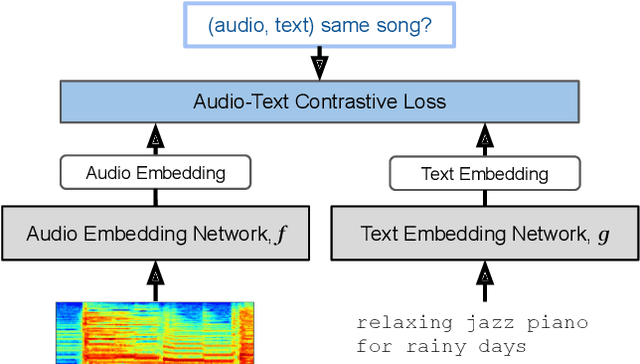


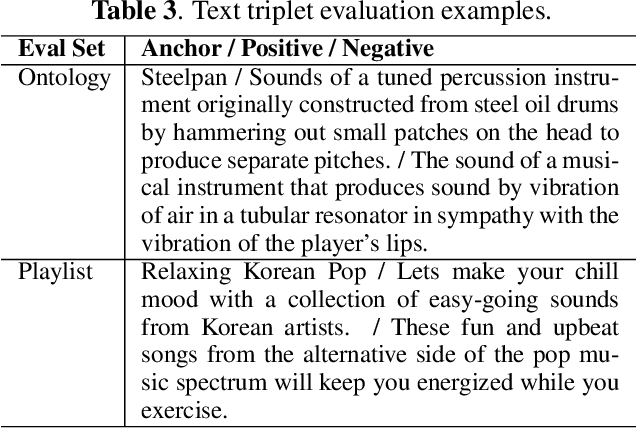
Abstract:Music tagging and content-based retrieval systems have traditionally been constructed using pre-defined ontologies covering a rigid set of music attributes or text queries. This paper presents MuLan: a first attempt at a new generation of acoustic models that link music audio directly to unconstrained natural language music descriptions. MuLan takes the form of a two-tower, joint audio-text embedding model trained using 44 million music recordings (370K hours) and weakly-associated, free-form text annotations. Through its compatibility with a wide range of music genres and text styles (including conventional music tags), the resulting audio-text representation subsumes existing ontologies while graduating to true zero-shot functionalities. We demonstrate the versatility of the MuLan embeddings with a range of experiments including transfer learning, zero-shot music tagging, language understanding in the music domain, and cross-modal retrieval applications.
Text-Driven Separation of Arbitrary Sounds
Apr 12, 2022

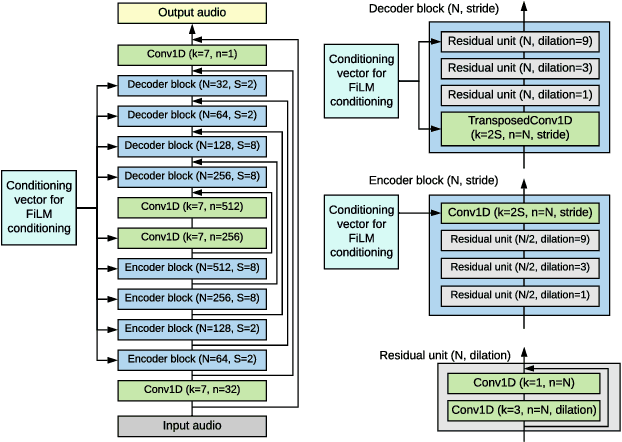

Abstract:We propose a method of separating a desired sound source from a single-channel mixture, based on either a textual description or a short audio sample of the target source. This is achieved by combining two distinct models. The first model, SoundWords, is trained to jointly embed both an audio clip and its textual description to the same embedding in a shared representation. The second model, SoundFilter, takes a mixed source audio clip as an input and separates it based on a conditioning vector from the shared text-audio representation defined by SoundWords, making the model agnostic to the conditioning modality. Evaluating on multiple datasets, we show that our approach can achieve an SI-SDR of 9.1 dB for mixtures of two arbitrary sounds when conditioned on text and 10.1 dB when conditioned on audio. We also show that SoundWords is effective at learning co-embeddings and that our multi-modal training approach improves the performance of SoundFilter.
Superbloom: Bloom filter meets Transformer
Feb 11, 2020



Abstract:We extend the idea of word pieces in natural language models to machine learning tasks on opaque ids. This is achieved by applying hash functions to map each id to multiple hash tokens in a much smaller space, similarly to a Bloom filter. We show that by applying a multi-layer Transformer to these Bloom filter digests, we are able to obtain models with high accuracy. They outperform models of a similar size without hashing and, to a large degree, models of a much larger size trained using sampled softmax with the same computational budget. Our key observation is that it is important to use a multi-layer Transformer for Bloom filter digests to remove ambiguity in the hashed input. We believe this provides an alternative method to solving problems with large vocabulary size.
Gradient-based Optimization for Bayesian Preference Elicitation
Nov 20, 2019



Abstract:Effective techniques for eliciting user preferences have taken on added importance as recommender systems (RSs) become increasingly interactive and conversational. A common and conceptually appealing Bayesian criterion for selecting queries is expected value of information (EVOI). Unfortunately, it is computationally prohibitive to construct queries with maximum EVOI in RSs with large item spaces. We tackle this issue by introducing a continuous formulation of EVOI as a differentiable network that can be optimized using gradient methods available in modern machine learning (ML) computational frameworks (e.g., TensorFlow, PyTorch). We exploit this to develop a novel, scalable Monte Carlo method for EVOI optimization, which is more scalable for large item spaces than methods requiring explicit enumeration of items. While we emphasize the use of this approach for pairwise (or k-wise) comparisons of items, we also demonstrate how our method can be adapted to queries involving subsets of item attributes or "partial items," which are often more cognitively manageable for users. Experiments show that our gradient-based EVOI technique achieves state-of-the-art performance across several domains while scaling to large item spaces.
 Add to Chrome
Add to Chrome Add to Firefox
Add to Firefox Add to Edge
Add to Edge